
Dr. J S. Famiglietti, is a Global Futures Professor and hydrologist with the School of Sustainability at Arizona State University (ASU) and he serves as the director for ASU’s Arizona Water Innovation Initiative. Famiglietti and his colleagues recently published an article in the Geophysical Research Letters journal (Abdelmohsen et al., 2025) with the American Geophysical Union (AGU) that describes the declining groundwater supplies in the lower Colorado River basin (LCRB). The methods for conducting this analysis are described in other publications (Rodell, Famiglietti et al., 2004; Rodell, Houser et al., 2004).
This research is valuable in providing important information regarding the current and future management of the Colorado River and LCRB groundwater supplies. In Arizona, 36% of the state’s water supply comes from the Colorado River and 41% from groundwater (Figure 1, ADWR, 2025). Agriculture uses 72% of the total Arizona water supply (Figure 2, ADWR, 2025).
As surface water supplies in the Colorado River have diminished over the past 25 years due to the ongoing drought in the southwest, conservation measures have resulted in reductions of allocations from the river. In response many areas, e.g. central Arizona, have turned to increasing groundwater withdrawals to supplement the difference.
In many discussions regarding the future management of Arizona water resources, groundwater sources are often considered for possible use and planning. In parts of the state with Active Management Areas (AMAs) there is a 100-year water supply requirement that must be proven before land can be developed (Figure 3; 1980 Groundwater Management Act (GWMA), Arizona Department of Water Resources (ADWR) 2017). Groundwater resources are often listed as future sources for development.
The Arizona GWMA has helped reduce groundwater depletion rates in some of the AMAs. But based on ADWR projections, some of the AMAs will not be able to meet the sustainability goals set in the GWMA to achieve safe yield by 2025 (ADWR, 2016, 2020). In addition, the Phoenix AMA is projected to encounter complete depletion by the end of the century based on groundwater simulations (ADWR, 2023).
It is important to note that only 18% of Arizona (by area) is subject to groundwater management, highlighting the urgent need for broader and more effective groundwater management across the entire LCRB.
Making assumptions on resources that might not exist is dangerous and reckless. In the process of trying to prove a 100-year water supply with a changing climate, the inclusion of groundwater resources are increasingly important. It is essential that we deal with facts and the truth and not hopeful thinking in planning for the future with issues like water resources.
This recent work by Abdelmohsen et al., (2025) is important in that it provides a good estimate of the groundwater supplies across the LCRB. Their results show very severely diminished levels of groundwater supplies in many parts of Arizona (Figure 4). Overall, this is good work with good methodology and conclusions.
However, in one aspect I believe their conclusions are flawed regarding their recommendations for agriculture to simply move away from water-intensive crops and flood irrigation and to utilize low-water use crops and irrigation systems such as drip irrigation to reduce overall water demand. That is a nice simple theory, and it is commonly advocated by scientists working in this arena and others that are probably well-intended but poorly informed of the facts (Richter et al., 2023 and Famiglietti, 2014).
Important conclusions from this study show that because of the increasing aridification along with increasing demand in this region, between 2015 to 2024 the level of groundwater storage across the LCRB decreased by a factor of 3. It is estimated that a total of 42.3 million acre-feet (MAF) of water has been lost in this period across the entire basin from all sources and that 27.8 MAF of this loss was from groundwater, which is estimated to be roughly equivalent to the full Lake Mead capacity.
Abdelmohsen et al., (2025) suggest that progress towards groundwater sustainability in the Colorado River basin could be achieved by reducing current annual extraction in balance current rates of depletion. This translates to a reduction in current annual groundwater depletion of 0.35 km3/year (0.28 MAF) in the upper basin and 1.5 km3/year (1.22 MAF) in the lower basin.
To put that in perspective, the total annual water consumption in Arizona is approximately 7.0 MAF (ADWR, 2025). The Drought Contingency Plan reduction for Tier 1 in Arizona is 512 thousand acre-feet (KAF) and Tier 2a is 592 KAF.
With a current population of 7.6M in Arizona and a projected population of 8.9 to 9.6M people by 2050, the pressures and competition for water among all sectors will be increasingly intense. In Maricopa County, the population is projected to reach between 6.0 and 7.0M by 2050.
Arizona agriculture will be continually forced to deal with the increasing urban population and the diminishing water supplies. The recent results coming from Abdelmohsen et al., (2025) provide a valuable assessment of groundwater supplies in the LCRB and Arizona and the importance of conservation measures.
This also reinforces the critical need for Arizona to develop functional groundwater legislation for areas beyond the established AMAs.
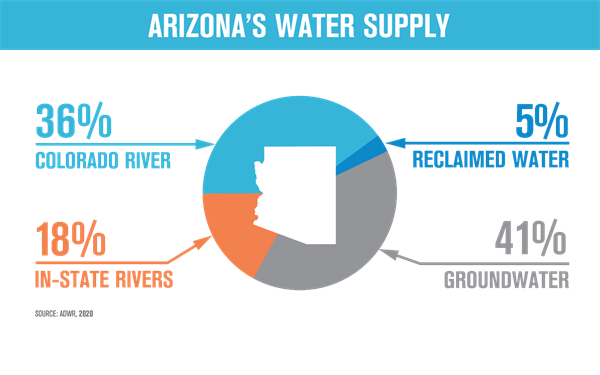
Figure 1. Sources of the Arizona water supply. Source: Arizona Department of Water
Resources (ADWR).
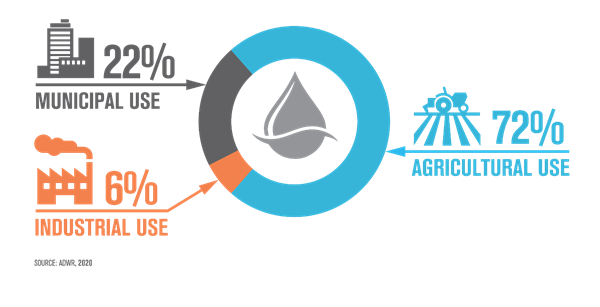
Figure 2. Arizona’s water use by sector. Source: Arizona Department of Water Resources
(ADWR).
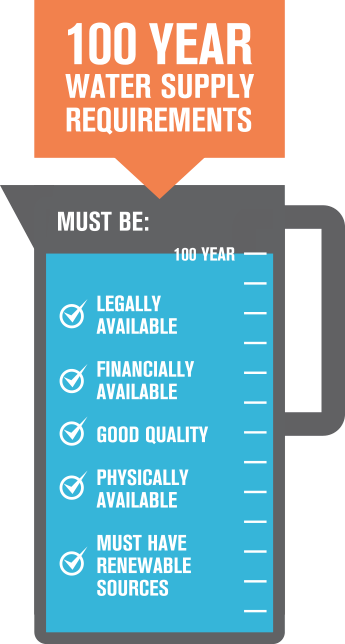
Figure 3. One-hundred-year water supply requirements for Active Management Areas in
Arizona. Source: ADWR, 2025.
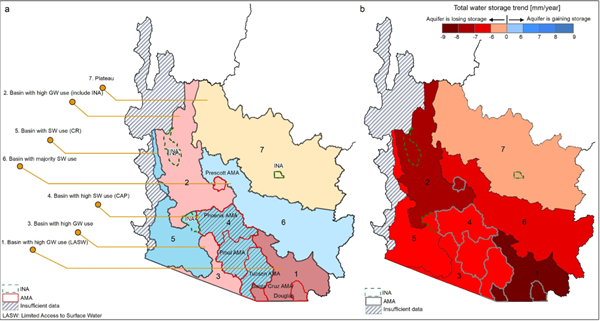
Figure 4. Categorization of groundwater basins based on water usage in the LCRB. (a) This
classification map utilizes data from the University of Arizona and the Arizona Department
of Water Resources (ADWR, 2016) to show the predominant source of water. Basins with
significant access to surface water are shown in blue; (b) TWS trends (mm/year) from
GRACE/FO for the groundwater basins in (a). The basins with the greatest loss rates are
shown by progressively darker red colors. Source: Abdelmohsen, et al. 2025.
References:
Abdelmohsen, K., Famiglietti, J. S.,Ao, Y.Z., Mohajer, B., & Chandanpurkar, H. A. 2025. Declining fresh water availability in the Colorado River basin threatens sustainability of its critical groundwater supplies. Geophysical Research Letters, 52,e2025GL115593. https://doi.org/10.1029/2025GL115593
Arizona Department of Water Resources (ADWR).2016. Arizona's strategic vision for water supply sustainability. Arizona Department of Water Resources (ADWR). Retrieved from https://new.azwater.gov/sites/default/files/ADWR_2016_Strategic_Vision.pdf
Arizona Department of Water Resources (ADWR). 2017. 1980 Groundwater Management Act. https://www.azwater.gov/news/articles/2017-01-23-3
Arizona Department of Water Resources (ADWR).2020 Arizona groundwater management report for active management areas 2020. Arizona Department of Water Resources (ADWR). Retrieved from https://new.azwater.gov
Arizona Department of Water Resources(ADWR). 2023. Groundwater sustainability simulations: 2023 Phoenix AMA groundwater outlook. Arizona Department of Water Resources (ADWR).
Arizona Department of Water Resources.2025. Arizona’s Water Supplies. https://www.arizonawaterfacts.com/water-your-facts
Famiglietti, J. S. 2014. The global groundwater crisis. Nature Climate Change, 4(11), 945–948. https://www.nature.com/articles/nclimate2425
Richter, B. D., Ao, Y., Lamsal, G., Wei, D., Amaya, M., Marston, L., & Davis, K. F. 2023. Alleviating water scarcity by optimizing crop mixes. Nature Water 2023, 1(12), 1035–1047. https://www.nature.com/articles/s44221-023-00155-9
Rodell, M., Famiglietti, J. S., Chen,J., Seneviratne, S. I., Viterbo, P., Holl, S., &Wilson, C. R. (2004a).Basin scale estimates of evapotranspiration using GRACE and other observations. Geophysical Research Letters, 31(20), L20504. https://doi.org/10.1029/2004GL020873
Rodell, M., Houser, P. R., Jambor, U., Gottschalck, J., Mitchell, K., Meng, C.‐J., et al. (2004b). The global land data assimilation system. Bulletin America Meteorology Social, 85(March),381–394. https://doi.org/10.1175/BAMS853381
I sent this out early this year, but I am resending the information as we have had few calls about the disease in desert southwest. Looks like we traded downy mildew for botrytis this year..
Botrytis rot is not considered a major problem in lettuce, but it can cause significant damage/loss when the field conditions are favorable for the pathogen. Cool wet conditions are favorable for the pathogen. Symptoms include water-soaked, brownish-gray to brownish-orange, soft wet rot that occurs on the oldest leaves in contact with the soil. Old leaves are more susceptible than young leaves and the fungus
can move into the healthy parts. Fuzzy gray growth can be observed in the disease area which is characteristic of the pathogen. In worse cases, the entire plant can collapse. Romaine cultivars, transplanted lettuce that are big and have leaves touching the soil are more susceptible.
The pathogen: Botrytis cinerea
Botrytis cinerea affects most vegetable and fruit crops, as well as a large number of shrubs, trees, flowers, and weeds. Outdoors Botrytis overwinters in the soil as mycelium on plant debris, and as black, hard, flat or irregular sclerotia in the soil and plant debris, or mixed with seed. The fungus is spread by anything that moves soil or plant debris, or transports sclerotia. The fungus requires free moisture (wet surfaces) for germination, and cool 60 to 77 F, damp weather with little wind for optimal infection, growth, sporulation, and spore release. Botrytis is also active at low temperatures, and can cause problems on vegetables stored for weeks or months at temperatures ranging from 32 to 50. Infection rarely occurs at temperatures above 77 F. Once infection occurs, the fungus grows over a range of 32 to 96 F.
Masses of microscopic conidia (asexual spores) are produced on the surface of colonized tissues in tiny grape-like clusters (see picture). They are carried by humid air currents, splashing water, tools, and clothing, to healthy plants where they initiate new infections. Conidia usually do not penetrate living tissue directly, but rather infect through wounds, or by first colonizing dead tissues (old flower petals, dying foliage, etc.) then growing into the living parts of the plant.
Disease management:

At the 2025 Southwest Ag Summit Field Demo a couple of weeks ago, many of the latest technologies were demonstrated in the field. Most were related to pest control. Several of the technologies demonstrated are new to the Yuma, AZ area. The recent technologies presented included two types of high precision spot sprayers for weeding and applying beneficial pesticides (Fig. 1a, Fig. 1b) and an AI based lettuce thinner. Manufacturers stated the technologies will be getting even better/more versatile soon. Both precision spot sprayer companies are developing models for small lettuce so that the machines can also be used for lettuce thinning. Also new was that the AI lettuce thinner technology is being further developed so that the device can be used also be used as a weeder. Several “older” pest control technologies also seemed to garner a lot of interest. These included an implement designed for cultivating high density crops (Fig. 1d), a camera guided cultivator equipped with in-row weeding tools (Fig. 1e) and a field scale drone sprayer (Fig. 1f).
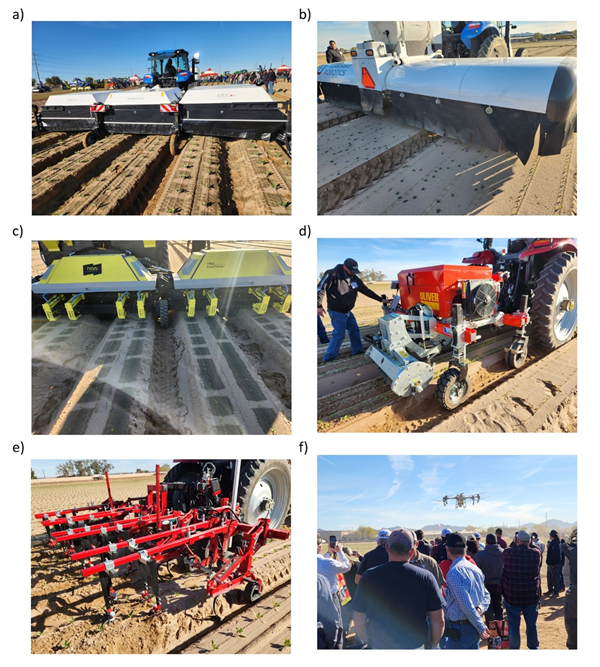
Fig. 1. Newer pest control technologies demonstrated at the 2025 Southwest Ag Summit
Field Demo included a) Ecorobotix1 Ara high precision spot sprayer, b) Verdant Robotics
Sharp Shooter, c) Niqo Robotics AI based lettuce thinner, d) Oliver high density
cultivator, e) Steketee IC Light camera guided cultivator and f) DJI Agras T50 drone
sprayer.
In our last update we invited you to come to the YAC to look at a broccoli trial we have in which we sprayed Trifluralin at 1.5 pt/ acre preemergence (PREE) incorporated mechanically. The application was made to the flat ground then incorporated with a disk at 4”depth. Then rows were built, and broccoli was direct seeded and germinated with sprinkler irrigation. Last year we saw injury in a non-disked Treflan treatment, so I didn’t include it in the trial. The same procedure was done with Prowl at 1pt with disked and non-disked plots.
Additional PREE treatments were Devrinol at 1pt/a, Prefar6qt/a, Goal tender at high rate of 16floz/a.
Prowl mechanically incorporated looks better than Non-incorporated in weed control as well as not showing phytotoxicity symptoms. Treflan, also mechanically incorporated looks similar to Prowl with a very small number of large weeds. The predominant weeds in this field are goosefoot and lambs quarter and are showing restricted growth not being as competitive with the broccoli.
Our observations in the trial as well as your field experience shows us with Treflan and Prowl available PREE and the post emergence herbicides such as Clethodim and Goal the absence of Cacthal can be mitigated to some degree. Again, you are welcome to come look at it at the Yuma Ag Center.
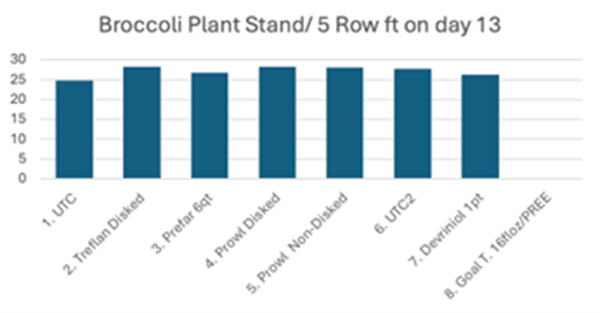
Treatments didn’t affect broccoli stand except Goal high rate PREE as expected.
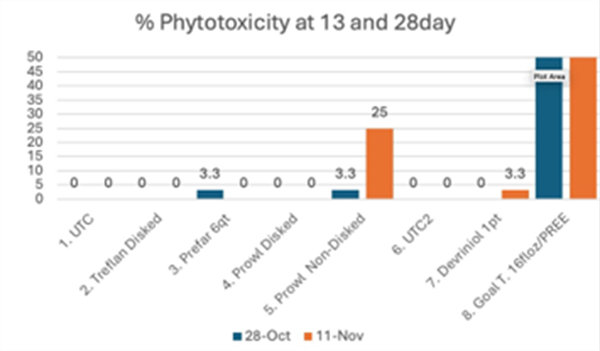
Prowl and Treflan applied on the flat and incorporated mechanically did not produced phytotoxicity symptoms at 13 and 28 days after planting.
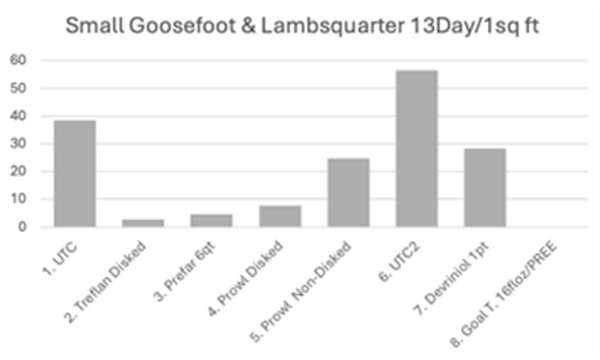
All weeds were about 0.5” at the time of this evaluation.
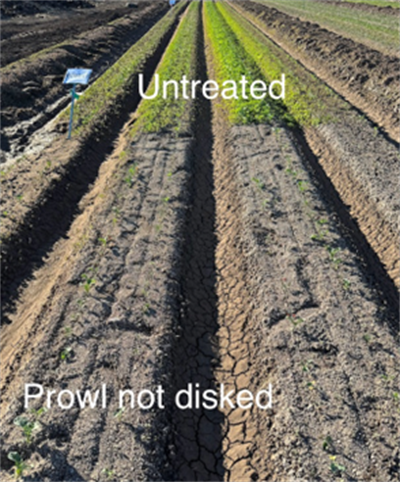
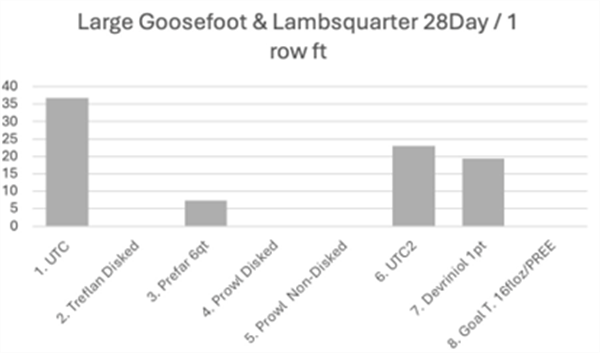
Some of the small weeds observed in the 13-day evaluation in the disked Prowl and Treflan died or didn’t grow by day 28.
Diamondback moth (DBM) has become a major challenge for Arizona brassica growers, with increasing reports of insecticide resistance and difficult fall and spring seasons.
To address this challenge, University of Arizona Extension entomologists and the Arizona Department of Agriculture, led by Dr. Wilfrid Calvin, collaborated to create new, practical guidelines for managing DBM in both transplant production and field settings.
The document offers practical, Arizona-focused strategies that can help prevent DBM and improve control.
The document can be found here: Guidelines for Effective Management of Diamondback Moth in Brassica CropsWe are pleased to share our recently published Extension article that investigates the impact of biostimulant applications on iceberg lettuce production under organic and conventional systems using subsurface drip irrigation in Yuma, Arizona. This study, conducted during the 2024–2025 season on a one-acre research field, examined how traditional and sensor-based irrigation scheduling, combined with biostimulant, influence crop growth, development, and yield.
Our findings revealed that while biostimulant had a limited effect on plant height in organic lettuce and only modest improvements in conventional production, the integration of biostimulant use with sensor-based irrigation increased yields. In the organic system, this combined approach increased yields up to 16.7 tons per acre. Similarly, in the conventional system, it achieved yields as high as 27 tons per acre, comparable to other conventional treatments. To read the full article and learn more about the study and its practical implications, please visit: Evaluating Biostimulant Effects on Growth and Yield of Iceberg Lettuce.This time of year, John would often highlight Lepidopteran pests in the field and remind us of the importance of rotating insecticide modes of action. With worm pressure present in local crops, it’s a good time to revisit resistance management practices and ensure we’re protecting the effectiveness of these tools for seasons to come. For detailed guidelines, see Insecticide Resistance Management for Beet Armyworm, Cabbage Looper, and Diamondback Moth in Desert Produce Crops .
VegIPM Update Vol. 16, Num. 20
Oct. 1, 2025
Results of pheromone and sticky trap catches below!!
Corn earworm: CEW moth counts declined across all traps from last collection; average for this time of year.
Beet armyworm: BAW moth increased over the last two weeks; below average for this early produce season.
Cabbage looper: Cabbage looper counts increased in the last two collections; below average for mid-late September.
Diamondback moth: a few DBM moths were caught in the traps; consistent with previous years.
Whitefly: Adult movement decreased in most locations over the last two weeks, about average for this time of year.
Thrips: Thrips adult activity increased over the last two collections, typical for late September.
Aphids: Aphid movement absent so far; anticipate activity to pick up when winds begin blowing from N-NW.
Leafminers: Adult activity increased over the last two weeks, about average for this time of year.







